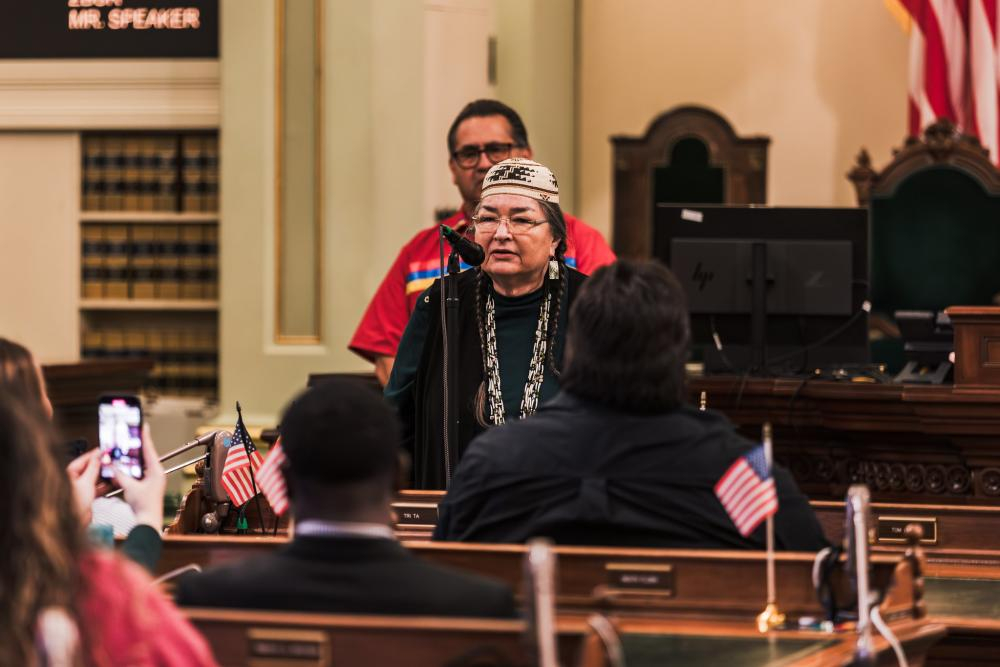
- Details
- By Chez Oxendine
- Higher Education
In early fall, Dr. Annette Reed concluded 26 years in various roles supporting Native American students at Sacramento State. Her tenure included serving as director for Native American Studies, chair for the Department of Ethnic Studies, and a part-time job with the college president’s office.
Reed, a member of the Tolowa Dee-ni' Nation, stayed retired for around one week when Sacramento State President J. Luke Wood asked her to come back to serve as dean for the school’s new Native American College.
“I didn’t know at first if I could cancel retirement, but we found out we could,” Reed said. “I thought about it for a little over a week - I talked about it with different people from local tribes, people on campus, and I sorted through it in my own mind. But when I thought about what this could mean for students, for Native communities and for leadership, I knew that I really needed to do this.”
The Native American College is a collective program of student cohorts, mentorship opportunities and specialized career and leadership training aimed primarily at Native students (though any student can apply, Reed notes). Students can apply either as first-years or as transfer students up through their junior year.
The college - the first of its kind under the California State University system - will launch its first cohorts in fall 2025. Reed spoke with Tribal Business News to talk about what’s ahead for those opportunities, and what success looks like for the program.
What’s the idea behind student cohorts?
Students in the college can all major in what they want, but they have to minor in Native American Studies. A lot of them will be taking very similar classes, so they’ll be in cohorts. The idea is that they will form their own connections with each other. Hopefully, they’ll form long-lasting relationships that they can draw upon for years.
How are you involving local tribes in developing the program?
We started creating an advisory board composed of different local tribes within the area, tribes throughout California, Native faculty and also some of the folks at community colleges.
What makes this such an important initiative that it brought you out of retirement?
There was a study in 2018 that was a campus climate survey, and that study revealed that two groups that felt the least comfortable on campus were Black students and Native American students. What I’ve noticed - not only in that report but in other reports - is that Native American students, somehow, constantly fall off the radar. People will say, oh there’s so few of them that they don’t make it on different research studies, but I think that’s a problem.
And a program like this can help solve that problem?
It’s not just a matter of recruiting Native students onto a campus, but having them feel like they can be successful while there, and I think this College helps address that with being able to have mentors, speakers that they can look at and connect to. It also helps them have other students you know, and people you can relate and study with, form these different networks and bonds with.
So it’s a matter of representation.
It sounds perhaps sappy or something to say that, but when someone looks at somebody and says, “oh, they did it, they went through and took these steps,” then they can say, “I can do that too.” It’s a way of showing students what success looks like, while at the same time not losing our Native communities’ differences or those students’ places within those communities.
That makes building those relationships crucial to the program, is that right?
It's all about relationship building, you know, whether someone's in business or teaching or within the community.
What’s the potential impact on surrounding tribal communities for a program like this?
Students may go and work for a tribe one day. A lot of our tribal communities need to have an educated workforce and educated leaders, and a lot of the skills they learn here in the College will be able to transfer in.
So what’s ahead for the college now that you’ve got the groundwork laid out?
We see this first year as a time to reflect and evaluate, because this is the first time that this has been developed at California State Universities. I'm sure that it's going to develop more, and we’re going to look at any parts of the program that are doing very well to further develop them.
Do you foresee those initial cohorts expanding?
If we look at 30 this coming fall 2025, then the next year, maybe 40 come in and so on, that at some point, there might be 200 students, you know, at the Native American college at one time. And who knows. I have no idea what 10 years is going to bring. We might even grow to more, okay, and I think that's a really good support program.
